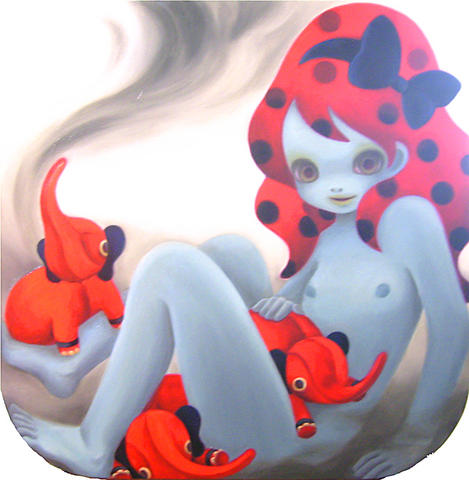Animamix art is taking the art world by storm - at least for the younger generation. Animamix, a portmanteau of "animation" and "comics," is as much a reflection of contemporary obsessions with virtual reality as it is an art movement.
As such, animamix artists are active in all areas of the creative industries - not just animation and comics - and cover a broad range of mediums including painting, sculpture, video, murals and installations - all of which can be seen at Taipei's Sun Yat-sen Memorial Hall beginning tomorrow. The exhibition is called New Epoch of Animamix Aesthetics and features 40 artists from Asia and America.
An obsession with and worship of youth, vivid visuals and bright colors are the hallmarks of animamix and other visual media that have gained popularity over the past 20 years.

PHOTOS: COURTESY OF METAPHYSICAL ART GALLERY
This seems natural as a whole generation has grown up on a bevy of comics, computer games and television programs which is becoming an innate part of cultures worldwide. As the Internet proliferates, multicultural voices are included in dialogue and artistic creation.
"Animamix Art is not about animation or comics themselves," said curator and Shih Chien University professor Victoria Lu (陸蓉之) in a recent interview. "It is an all-inclusive concept of the aesthetic choice of the new century."
It's an aesthetic, Lu says, that celebrates different dimensions of time and space.

"It is a kind of art beyond art, time beyond time, space beyond space and life beyond life," she said.

President William Lai (賴清德) has championed Taiwan as an “AI Island” — an artificial intelligence (AI) hub powering the global tech economy. But without major shifts in talent, funding and strategic direction, this vision risks becoming a static fortress: indispensable, yet immobile and vulnerable. It’s time to reframe Taiwan’s ambition. Time to move from a resource-rich AI island to an AI Armada. Why change metaphors? Because choosing the right metaphor shapes both understanding and strategy. The “AI Island” frames our national ambition as a static fortress that, while valuable, is still vulnerable and reactive. Shifting our metaphor to an “AI Armada”

When Taiwan was battered by storms this summer, the only crumb of comfort I could take was knowing that some advice I’d drafted several weeks earlier had been correct. Regarding the Southern Cross-Island Highway (南橫公路), a spectacular high-elevation route connecting Taiwan’s southwest with the country’s southeast, I’d written: “The precarious existence of this road cannot be overstated; those hoping to drive or ride all the way across should have a backup plan.” As this article was going to press, the middle section of the highway, between Meishankou (梅山口) in Kaohsiung and Siangyang (向陽) in Taitung County, was still closed to outsiders

The older you get, and the more obsessed with your health, the more it feels as if life comes down to numbers: how many more years you can expect; your lean body mass; your percentage of visceral fat; how dense your bones are; how many kilos you can squat; how long you can deadhang; how often you still do it; your levels of LDL and HDL cholesterol; your resting heart rate; your overnight blood oxygen level; how quickly you can run; how many steps you do in a day; how many hours you sleep; how fast you are shrinking; how

“‘Medicine and civilization’ were two of the main themes that the Japanese colonial government repeatedly used to persuade Taiwanese to accept colonization,” wrote academic Liu Shi-yung (劉士永) in a chapter on public health under the Japanese. The new government led by Goto Shimpei viewed Taiwan and the Taiwanese as unsanitary, sources of infection and disease, in need of a civilized hand. Taiwan’s location in the tropics was emphasized, making it an exotic site distant from Japan, requiring the introduction of modern ideas of governance and disease control. The Japanese made great progress in battling disease. Malaria was reduced. Dengue was